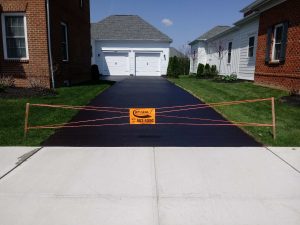Swift Solutions for Asphalt Patch Repair: Optimum Sealing Strategies
Wiki Article
Cold Mix Asphalt Vs. Hot Mix Asphalt: Which Is Right for You?
Structure Distinctions
Cold mix and warm mix asphalts differ dramatically in their composition, with distinct qualities that affect their efficiency and applications. Cold mix asphalt is generated by emulsifying the asphalt binder with water and an emulsifying representative before blending it with aggregate. This technique enables the asphalt to be convenient at reduced temperature levels, making it ideal for short-term fixings and for usage in cooler climate condition. Warm mix asphalt, on the other hand, is manufactured at high temperatures, commonly in between 300-350 ° F, which helps to achieve far better compaction and a more resilient end product. The hot mix asphalt production process includes warming the accumulation and asphalt binder independently prior to incorporating them at the asphalt plant.
In addition, cool mix asphalt has a tendency to be less dense and more flexible than warm mix asphalt. This flexibility makes it far better matched for locations with greater levels of motion, such as driveways or roads with rush hour. On the other hand, hot mix asphalt is understood for its high sturdiness and resistance to rutting and breaking, making it a favored choice for freeways and high-traffic roadways where durability is essential.
Installation Refine Variations
The process of installing cool mix and hot mix asphalt exhibits remarkable differences in their treatments and needs. Cold mix asphalt, being an extra versatile product, can be applied directly from the bag or container onto the pothole or harmed area. It calls for very little preparation work, such as cleansing the area and compacting the cool combine with hand devices. This makes it a hassle-free option for short-term and fast repairs. On the other hand, warm mix asphalt demands a more elaborate installment process. It entails heating the mixture to heats prior to laying it down on a correctly ready base. The preparation consists of compacting the base, using a tack coat, and making use of heavy equipment like pavers and compactors for a smooth and durable finish. Because of the home heating requirements, warm mix asphalt installations are usually lugged out by professionals with customized equipment, ensuring a much more structurally audio and long-term outcome.Toughness and Longevity Aspects
When considering asphalt options, sturdiness and longevity are vital variables to examine for long lasting sidewalk efficiency. Hot mix asphalt (HMA) is recognized for its outstanding sturdiness and durability.
In terms of durability, HMA typically outmatches CMA because of its superior toughness and resistance residential or commercial properties. HMA sidewalks have a longer service life, calling for less frequent repairs and upkeep, which can equate to set you back savings in the future. Furthermore, HMA sidewalks are more quickly customizable to satisfy specific task requirements, additionally enhancing their durability.
Cost Factors To Consider
Considering the financial implications is a critical facet when evaluating the choice in between hot mix asphalt (HMA) and cold mix asphalt (CMA) for sidewalk jobs. While the preliminary expense of hot mix asphalt is generally higher than that of chilly mix asphalt, HMA frequently provides an extra cost-efficient solution in the long run due to its exceptional sturdiness and durability.In enhancement to product costs, it's necessary to take into consideration the expenditures linked with installment and maintenance when contrasting HMA and CMA. Eventually, the decision between HMA and CMA must take into account not just the initial cost however also the long-lasting economic ramifications to figure out the most cost-efficient alternative for the particular pavement project.
Environmental Effect Comparison
Contrast of the ecological impacts between hot mix asphalt (HMA) and cold mix asphalt (CMA) exposes distinctive distinctions in sustainability techniques. HMA manufacturing requires high temperature levels, causing enhanced power usage and greenhouse gas emissions. The process also launches volatile organic compounds (VOCs) and harmful air toxins (HAPs) right into the atmosphere. On the other hand, CMA is generated and applied at lower temperature levels, reducing energy use and emissions considerably. The lower production temperatures of CMA lead to lowered gas consumption and lower degrees of carbon dioxide discharges, making it a more eco friendly option.In addition, using CMA frequently involves recycling existing asphalt sidewalk, advertising resource preservation and minimizing the amount of waste sent out to landfills. This recycling facet better improves the sustainability of CMA compared to HMA. On the whole, when thinking about the environmental influence, CMA arises as a more eco sustainable selection because of its reduced energy needs, minimized exhausts, and the possibility for reusing existing products. By choosing CMA over HMA, roadway building jobs can add favorably to environmental conservation efforts.
Verdict
In final thought, the selection in between cool mix asphalt (CMA) and warm mix asphalt (HMA) depends upon numerous elements such as composition, installment process, toughness, longevity, expense, and environmental effect. asphalt repair. While CMA offers a quick and cost-efficient service for minor repair services, HMA ensures superior sturdiness and long life for rush hour locations. Think about these variables thoroughly to figure out which kind of asphalt is the right choice for your paving needs

Thinking about the financial ramifications is an essential aspect when reviewing the choice between warm mix asphalt (HMA) and chilly mix asphalt (CMA) for pavement jobs. While the initial expense of warm mix asphalt is typically higher than that of cold mix asphalt, HMA often provides a more affordable service in the lengthy run due to its remarkable resilience and long life. angle parking.Contrast of the ecological impacts between warm mix asphalt (HMA) and cold mix asphalt (CMA) reveals distinctive distinctions in sustainability techniques.In verdict, asphalt patch repair the option between cold mix asphalt (CMA) and hot mix asphalt (HMA) depends on various elements such as composition, setup process, resilience, durability, cost, and environmental effect
Report this wiki page